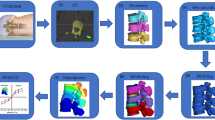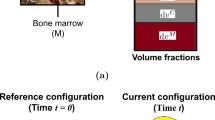Abstract
Fractured vertebral bodies are often stabilized by vertebroplasty. Several parameters, including fracture type, cement filling shape, cement volume, elastic moduli of cement, cancellous bone and fractured region, may all affect the stresses in the augmented vertebral body and in bone cement. The aim of this study was to determine numerically the effects of these input parameters on the stresses caused. In a probabilistic finite element study, an osteoligamentous model of the lumbar spine was employed. Seven input parameters were simultaneously and randomly varied within appropriate limits for >110 combinations thereof. The maximum von Mises stresses in cancellous and cortical bone of the treated vertebral body L3 and in bone cement were calculated. The loading cases standing, flexion, extension, lateral bending, axial rotation and walking were simulated. In a subsequent sensitivity analysis, the coefficients of correlation and determination of the input parameters on the von Mises stresses were calculated. The loading case has a strong influence on the maximum von Mises stress. In cancellous bone, the median value of the maximum von Mises stresses for the different input parameter combinations varied between 1.5 (standing) and 4.5 MPa (flexion). The ranges of the stresses are large for all loading cases studied. Depending on the loading case, up to 69% of the maximum stress variation could be explained by the seven input parameters. The fracture shape and the elastic modulus of the fractured region have the highest influence. In cortical bone, the median values of the maximum von Mises stresses varied between 31.1 (standing) and 61.8 MPa (flexion). The seven input parameters could explain up to 80% of the stress variation here. It is the fracture shape, which has always the highest influence on the stress variation. In bone cement, the median value of the maximum von Mises stresses varied between 3.8 (standing) and 12.7 MPa (flexion). Up to 75% of the maximum stress variation in cement could be explained by the seven input parameters. Fracture shape, and the elastic moduli of bone cement and of the fracture region are those input parameters with the highest influence on the stress variation. In the model with no fracture, the maximum von Mises stresses are generally low. The present probabilistic and sensitivity study clearly showed that in vertebroplasty the maximum stresses in the augmented vertebral body and in bone cement depend mainly on the loading case and fracture shape. Elastic moduli of cement, fracture region and cancellous bone as well as cement volume have sometimes a moderate effect while number and symmetry of cement plugs have virtually no effect on the maximum stresses.










Similar content being viewed by others
References
Heini PF, Orler R (2004) Kyphoplasty for treatment of osteoporotic vertebral fractures. Eur Spine J 13:184–192
Garfin SR, Yuan HA, Reiley MA (2001) New technologies in spine: kyphoplasty and vertebroplasty for the treatment of painful osteoporotic compression fractures. Spine 26:1511–1515
Blattert TR, Jestaedt L, Weckbach A (2009) Suitability of a calcium phosphate cement in osteoporotic vertebral body fracture augmentation: a controlled, randomized, clinical trial of balloon kyphoplasty comparing calcium phosphate versus polymethylmethacrylate. Spine (Phila Pa 1976) 34:108–114
Magerl F, Aebi M, Gertzbein SD, Harms J, Nazarian S (1994) A comprehensive classification of thoracic and lumbar injuries. Eur Spine J 3:184–201
Shin DA, Kim KN, Shin HC, Kim SH, Yoon DH (2008) Progressive collapse of PMMA-augmented vertebra: a report of three cases. Zentralbl Neurochir 69:43–46
Belkoff SM, Mathis JM, Jasper LE, Deramond H (2001) The biomechanics of vertebroplasty. The effect of cement volume on mechanical behavior. Spine 26:1537–1541
Liebschner MA, Rosenberg WS, Keaveny TM (2001) Effects of bone cement volume and distribution on vertebral stiffness after vertebroplasty. Spine 26:1547–1554
Molloy S, Mathis JM, Belkoff SM (2003) The effect of vertebral body percentage fill on mechanical behavior during percutaneous vertebroplasty. Spine 28:1549–1554
Rohlmann A, Zander T, Jony A, Weber U, Bergmann G (2005) Einfluss der Wirbelkörpersteifigkeit vor und nach Vertebroplastik auf den intradiskalen Druck. Biomed Tech (Berl) 50:148–152
Sun K, Liebschner MA (2004) Biomechanics of prophylactic vertebral reinforcement. Spine 29:1428–1435
Baroud G, Nemes J, Heini P, Steffen T (2003) Load shift of the intervertebral disc after a vertebroplasty: a finite-element study. Eur Spine J 12:421–426
Polikeit A, Nolte LP, Ferguson SJ (2003) The effect of cement augmentation on the load transfer in an osteoporotic functional spinal unit: finite-element analysis. Spine 28:991–996
Rohlmann A, Zander T, Bergmann G (2006) Spinal loads after osteoporotic vertebral fractures treated by vertebroplasty or kyphoplasty. Eur Spine J 15:1255–1264
Villarraga LM, Cripton PA, Bellezza AJ, Berlemann U, Kurtz SM, Edidin AA (2004) Knochen und Knochen-Zement-Belastungen in der thorakolumbalen Wirbelsäule nach Kyphoplastik. Eine Finite-Element-Studie. Orthopade 33:48–55
Chevalier Y, Pahr D, Charlebois M, Heini P, Schneider E, Zysset P (2008) Cement distribution, volume, and compliance in vertebroplasty: some answers from an anatomy-based nonlinear finite element study. Spine 33:1722–1730
Teo J, Wang SC, Teoh SH (2007) Preliminary study on biomechanics of vertebroplasty: a computational fluid dynamics and solid mechanics combined approach. Spine 32:1320–1328
Keller TS, Kosmopoulos V, Lieberman IH (2005) Vertebroplasty and kyphoplasty affect vertebral motion segment stiffness and stress distributions: a microstructural finite-element study. Spine 30:1258–1265
Haldar A, Mahadevan S (2000) Probability, reliability, and statistical methods in engineering design. Wiley, New York
Dar FH, Meakin JR, Aspden RM (2002) Statistical methods in finite element analysis. J Biomech 35:1155–1161
Ananthakrishnan D, Berven S, Deviren V, Cheng K, Lotz JC, Xu Z, Puttlitz CM (2005) The effect on anterior column loading due to different vertebral augmentation techniques. Clin Biomech (Bristol, Avon) 20:25–31
Davis JW, Grove JS, Wasnich RD, Ross PD (1999) Spatial relationships between prevalent and incident spine fractures. Bone 24:261–264
Jensen ME, Dion JE (2000) Percutaneous vertebroplasty in the treatment of osteoporotic compression fractures. Neuroimaging Clin N Am 10:547–568
Wilcox RK (2006) The biomechanical effect of vertebroplasty on the adjacent vertebral body: a finite element study. Proc Inst Mech Eng [H] 220:565–572
Zander T, Rohlmann A, Bock B, Bergmann G (2007) Biomechanische Konsequenzen von verschiedenen Positionierungen bewegungserhaltender Bandscheibenimplantate. Eine Finite-Elemente-Studie an der Lendenwirbelsäule. Orthopade 36:205–211
Zander T, Rohlmann A, Calisse J, Bergmann G (2001) Estimation of muscle forces in the lumbar spine during upper-body inclination. Clin Biomech 16:S73–S80
Rohlmann A, Bauer L, Zander T, Bergmann G, Wilke HJ (2006) Determination of trunk muscle forces for flexion and extension by using a validated finite element model of the lumbar spine and measured in vivo data. J Biomech 39:981–989
Zander T, Rohlmann A, Bergmann G (2009) Influence of different artificial disc kinematics on spine biomechanics. Clin Biomech (Bristol, Avon) 24:135–142
Rohlmann A, Zander T, Bock B, Bergmann G (2008) Effect of position and height of a mobile core type artificial disc on the biomechanical behaviour of the lumbar spine. Proc Inst Mech Eng [H] 222:229–239
Eberlein R, Holzapfel GA, Schulze-Bauer CAJ (2000) An anisotropic model for annulus tissue and enhanced finite element analysis of intact lumbar disc bodies. Comp Meth Biomech Biomed Eng 4:209–229
Rohlmann A, Zander T, Bergmann G (2005) Effect of total disc replacement with ProDisc on the biomechanical behavior of the lumbar spine. Spine 30:738–743
Nolte LP, Panjabi MM, Oxland TR (1990) Biomechanical properties of lumbar spinal ligaments. In: Heimke G, Soltesz U, Lee AJC (eds) Clinical implant materials, advances in biomaterials, vol 9. Elsevier, Heidelberg, pp 663–668
Shirazi-Adl A, Ahmed AM, Shrivastava SC (1986) Mechanical response of a lumbar motion segment in axial torque alone and combined with compression. Spine 11:914–927
Ueno K, Liu YK (1987) A three-dimensional nonlinear finite element model of lumbar intervertebral joint in torsion. J Biomech Eng 109:200–209
Patwardhan AG, Havey RM, Meade KP, Lee B, Dunlap B (1999) A follower load increases the load-carrying capacity of the lumbar spine in compression. Spine 24:1003–1009
Rohlmann A, Neller S, Claes L, Bergmann G, Wilke H-J (2001) Influence of a follower load on intradiscal pressure and intersegmental rotation of the lumbar spine. Spine 26:E557–E561
Rohlmann A, Zander T, Rao M, Bergmann G (2009) Applying a follower load delivers realistic results for simulating standing. J Biomech 42:1520–1526
Rohlmann A, Zander T, Rao M, Bergmann G (2009) Realistic loading conditions for upper body bending. J Biomech 42:884–890
Rohlmann A, Claes L, Bergmann G, Graichen F, Neef P, Wilke H-J (2001) Comparison of intradiscal pressures and spinal fixator loads for different body positions and exercises. Ergonomics 44:781–794
Rozumalski A, Schwartz MH, Wervey R, Swanson A, Dykes DC, Novacheck T (2008) The in vivo three-dimensional motion of the human lumbar spine during gait. Gait Posture 28:378–384
Gurdak JJ, McCray JE, Thyne G, Qi SL (2007) Latin hypercube approach to estimate uncertainty in ground water vulnerability. Ground Water 45:348–361
Hulme PA, Boyd SK, Heini PF, Ferguson SJ (2009) Differences in endplate deformation of the adjacent and augmented vertebra following cement augmentation. Eur Spine J 18:614–623
Fyhrie DP, Vashishth D (2000) Bone stiffness predicts strength similarly for human vertebral cancellous bone in compression and for cortical bone in tension. Bone 26:169–173
Ikenaga M, Hardouin P, Lemaitre J, Andrianjatovo H, Flautre B (1998) Biomechanical characterization of a biodegradable calcium phosphate hydraulic cement: a comparison with porous biphasic calcium phosphate ceramics. J Biomed Mater Res 40:139–144
Goel VK, Ramirez SA, Kong W, Gilbertson LG (1995) Cancellous bone Young’s modulus variation within the vertebral body of a ligamentous lumbar spine—application of bone adaptive remodeling concepts. J Biomech Eng 117:266–271
Shirazi-Adl SA, Shrivastava SC, Ahmed AM (1984) Stress analysis of the lumbar disc-body unit in compression. A three-dimensional nonlinear finite element study. Spine 9:120–134
Rohlmann A, Zander T, Schmidt H, Wilke H-J, Bergmann G (2006) Analysis of the influence of disc degeneration on the mechanical behaviour of a lumbar motion segment using the finite element method. J Biomech 39:2484–2490
Sharma M, Langrana NA, Rodriguez J (1995) Role of ligaments and facets in lumbar spinal stability. Spine 20:887–900
Acknowledgments
This study was financially supported by Heraeus Medical GmbH, Wehrheim, Germany and the Deutsche Forschungsgemeinschaft, Bonn, Germany (Ro 581/17-2). Finite element analyses were performed at the Norddeutscher Verbund für Hoch-und Höchstleistungsrechnen (HLRN). The authors thank N.K. Burra for technical assistance.
Author information
Authors and Affiliations
Corresponding author
Rights and permissions
About this article
Cite this article
Rohlmann, A., Boustani, H.N., Bergmann, G. et al. A probabilistic finite element analysis of the stresses in the augmented vertebral body after vertebroplasty. Eur Spine J 19, 1585–1595 (2010). https://doi.org/10.1007/s00586-010-1386-x
Received:
Revised:
Accepted:
Published:
Issue Date:
DOI: https://doi.org/10.1007/s00586-010-1386-x




